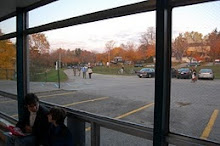You can find more eager talk about "hitting a bottom" or "what a bottom looks like" on real estate sites recently than on porno sites.
Calculated Risk analyzes the latest bottom caller in Housing: Another Day, Another WSJ Bottom Call.
The analysis is interesting, but the question is academic. Real estate prices historically track inflation. It's not like stocks. Stock prices historically grow faster than inflation. They're also more volatile and more liquid. Timing the stock market, if you could do it, could make you rich quickly. Real estate on the other hand does not give you daily price updates, is more difficult to buy and sell, and typically stays around the same inflation-adjusted price.
After the current real estate market anomaly unwinds, prices will return to historical levels, and people will think about real estate ups and downs about as much as people thought about them during the tech bubble. "Oh, real estate prices outpaced inflation by 1% this year. What do I care?"
You will know the market anomaly is over because prices will be their historical parity with rents. Real estate investors will plan to make money on their properties' cash flow rather than by speculating on price volatility.
This focus on bottoms only serves people who sell real estate or provide financing for real estate. They argue that real estate will be the engine of growth in the next economic cycle because they want to make a bailout (or series of small bailout measures) more politically palatable.
Thursday, May 8, 2008
Subscribe to:
Post Comments (Atom)


No comments:
Post a Comment